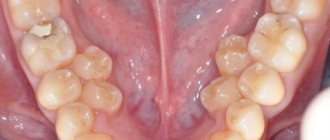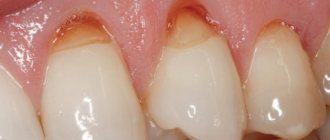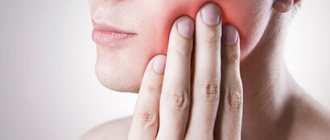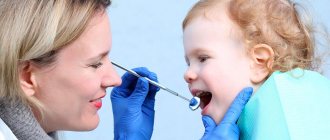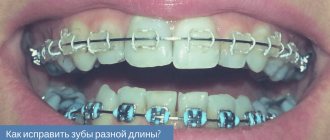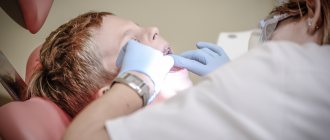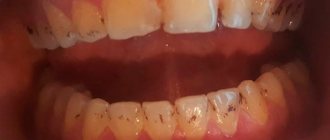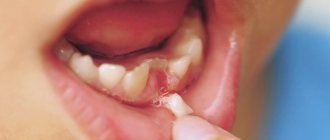If the child’s jaw develops correctly, then the replacement of teeth occurs as follows: first, the roots of the baby teeth dissolve, then the teeth fall out of the gum tissue, after which new, already permanent ones grow in their place. This is a natural process that does not require intervention.
If everything goes well, then by a certain age all baby teeth will be removed from the mouth, and straight and healthy permanent teeth will grow in their place. However, the picture does not always look like this. Sometimes parents notice that their child’s second row of permanent teeth grows even before the baby tooth falls out.
You need to pay attention to this, since new teeth can be impacted, that is, partially remain in the gums. And retention, in turn, can lead to inflammation, fever and sometimes even suppuration. Therefore, at the first signs that the child’s second row of teeth is growing, you should immediately contact a pediatric dentist.
Polyodontia is an abnormal number of teeth.
In medicine, this disease is often called hyperdontia, and “extra” dental elements are called supernumerary teeth. Research is still being conducted into why this pathology occurs. Most scientists associate it with disturbances in the formation of tooth germs.
Nature provides that a person grows no more than 20 milk teeth and 32 permanent teeth in a lifetime, but exceptions occur, and in our time quite often. According to statistics, on average, dental anomalies occur in 2% of the world's population, most often in men.
In 2014 alone, two operations were performed, in one of which 80 teeth were removed, and in the other, a record 232 teeth. Until this time, the maximum figure was 37 teeth.
The most common hyperdontia (anomaly in the number of teeth) is an anomaly of the upper incisors. Supernumerary teeth are less common among the lower incisors and in other parts of the jaw. They can come in a wide variety of shapes and sizes. These are usually small, cone-shaped teeth.
Extra teeth lead to deformation of the dentition, so it is recommended to remove supernumerary elements. Another reason for removal is that most patients with this pathology have a lisp.
The formation of extra teeth is quite common today. According to statistics, 70% of patients have only one extra incisor, in 25% of cases – 2 supernumerary elements, and only 5% of all patients have 3 or more teeth during examination.
How to distinguish baby teeth from permanent ones?
Both molars and baby teeth have a similar structure, but have a number of external differences.
- Thus, milk ones are on average lighter and whiter than permanent ones, which are distinguished by a yellowish enamel tone.
- On average, a molar is larger than its primary tooth.
- Permanent ones have a thicker layer of hard tissue and a less developed pulp.
- Dairy varieties have thinner and shorter roots.
It is important for all parents to remember that both baby and permanent teeth of children must be protected, and any problems that arise in their growth and development must be resolved immediately. Specialists from the “A-Medic” network of medical clinics can help them with this.
Causes of polyodontia
Medicine has not yet found an exact answer to the question of what are the causes of supernumerary teeth. Scientists put forward several hypotheses:
- Atavism. Supernumerary teeth are explained by the fact that the dental system strives to return to the original number of elements laid down by nature. There is evidence that our ancestors had 6 incisors on both the lower and upper jaws. As a result, many doctors consider atavism to be the cause of the development of polyodontia in humans.
- Splitting of the tooth germ. Even in the embryonic period, the activity of the dental plate is disrupted in the child, as a result of which hyperdontia is formed. Violations can be caused by viruses, poor ecology, drugs, medications prohibited during pregnancy, alcohol and other factors. This hypothesis is increasingly supported today, because recently the disease has been rapidly progressing due to bad habits and poor ecology.
The causes of hyperdontia continue to be researched. Scientists cannot give an exact explanation for this anomaly, but most of them are inclined to the second hypothesis - the splitting of the tooth germ at the embryonic stage.
What does polyodontia look like?
Quite often, extra teeth are almost indistinguishable from normal ones. It is not uncommon for them to grow in the form of a drop or a thorn. These dental elements can appear either individually or fused with permanent ones. They can form tooth-like formations and entire arrays of teeth.
Also in medical practice, there are cases where polyodontia was hidden and was detected only by radiography. There are many different cases of abnormal development of the number of teeth, and if you notice symptoms, you should definitely contact the dentist.
Types of polyodontia disease
Polyodontia in the oral cavity manifests itself in different ways. By studying the statistics, signs and symptoms of the disease, dentists were able to classify the types of this anomaly.
Depending on the origin, the disease is divided into two types:
- False polyodontia. Provides for a baby tooth that does not fall out, regardless of the person’s age. At the same time, it fulfills its functions, does not create discomfort to the bite, and is firmly fixed in the patient’s jaw. In addition, teeth fused together and other anomalies are classified as a false type of disease.
- True polyodontia. It can be caused by genetic predisposition, as well as terogenic factors. At the same time, extra molars begin to form in the human jaw.
Reasons why teeth grow second row
Teething pathology can be caused by the following factors:
- chronic diseases, various infections;
- problems arising during the development of milk units, which subsequently has a negative impact on the formation of root incisors or molars;
- genetic predisposition;
- unbalanced diet;
- deficiency in the body of vitamins and minerals necessary for the proper formation of teeth;
- incorrect location of the primordia.
As for the placement of extra teeth, dentists distinguish the following types of disease:
- Typical hyperdontia. Applies to those patients in whom extra teeth appear only in the dentition and do not extend beyond it. Many scientists are confident that this is simply heredity, because our ancestors had a more developed dental system than modern people.
- Atypical hyperdontia. It occurs much less frequently and is characterized by the appearance of teeth outside the dentition.
In case of anomalies with baby teeth, the latter pose almost no threat. On the contrary, such a tooth can last a lifetime. But the permanent molars, over which the supernumeraries grow, should be removed, if only because it is not aesthetically pleasing.
Often, the patient grows extra fangs or incisors, or even several front teeth at once. In addition to a ruined smile, the disease can cause serious complications if the necessary measures are not taken in time.
Possible complications with polyodontia
The most common consequence of polyodontia is an unaesthetic smile, facial disproportions, as well as impaired diction, usually a lisp. In especially severe cases, extra teeth are noticeable even at rest, when the mouth is closed. Lips may protrude unnaturally or jaws may not close properly.
Additional teeth put pressure on the complete ones and take up space in the dentition. Teeth can shift, rotate along an axis, be located outside the row - on the palate, under the tongue, etc. Supernumerary units of the row cause crowding of the teeth. This complicates hygiene, provokes the accumulation of plaque, the formation of tartar, multiple caries and complications in the form of pulpitis and periodontitis.
When crowding occurs, the tissue around the teeth does not form correctly. In addition, the chewing load is distributed incorrectly. This can cause diseases of periodontal tissues - gingivitis, periodontitis, periodontal disease, in which deep periodontal pockets are formed, tooth mobility and further loss are observed. When overcrowding occurs, normal prosthetics are almost impossible without prior orthodontic treatment.
This disease leads to functional disorders, cosmetic defects, and therefore is one of the causes of self-doubt and interferes with normal communication and adaptation in society.
Symptoms of the disease in children
The first supernumerary teeth in children appear before birth or in the first six months of life. The main inconvenience they cause is difficulty in feeding.
Polyodontia of primary teeth in older children occurs with symptoms similar to the eruption of regular teeth. In this case it is observed:
- temperature increase;
- swelling of the gums in the place where the tooth should erupt;
- pain;
- excessive salivation;
- swelling of the nasal mucosa;
- loose stool.
Symptoms are especially severe when extra teeth appear in the upper palate.
If hyperdontia makes itself felt in a two-year-old child, this can interfere with the formation of normal speech. In turn, due to injury to the tongue and mucous membranes, some kind of inflammation constantly appears in the oral cavity.
When supernumerary teeth appear in very noticeable places in school-age children, ridicule towards the patient may occur, which is fraught with the development of psychological problems and complexes in the future.
What to do? Where to run?
If the problem affects a baby tooth, then intervention will be required only if the baby tooth begins to interfere with the eruption of the permanent one. Most often, the dentist simply observes and the problem is solved on its own.
If the tooth causes severe discomfort, and the nerve is deep in the tissues, then the “extra” tissue is removed, bringing the crown size to almost normal. In the rarest cases, a tooth is divided surgically, but only when there are two healthy roots and two pulp chambers. Endodontic treatment may then be required, which involves removing the pulp and filling the root canals with a special material. After this, with the help of a filling or crown, the tooth is given an aesthetically attractive appearance and the patient is free to enjoy a new smile.
Symptoms of hyperdontia in adults
Polyodontia affects permanent teeth more often than baby teeth. An adult usually develops dystopic and impacted supernumerary teeth.
Dystopic teeth are those that appear outside the dental arch. Most often they erupt on the lingual surface of the gums and in the palate. With this form of the disease, the patient typically:
- poor pronunciation of sounds;
- noticeable malocclusion;
- change in the usual arrangement of teeth: curvature of the angle at which they grow, as well as their rotation
- around its axis;
- frequent injury to the oral mucosa and, as a result, its inflammation;
- disruption of chewing processes, resulting in digestive problems.
Among other things, dystopic teeth often cause psychological problems. Due to a non-aesthetic, and sometimes completely unattractive smile, the patient becomes withdrawn and uncommunicative. Psychological problems, in turn, cause chronic diseases of the endocrine, digestive and nervous systems.
Impacted supernumerary teeth are teeth that do not erupt, but continue to remain in the bone tissue of the human jaw. Often they hardly make themselves felt until complications begin. Dentists diagnose this anomaly during a routine examination of the patient.
This abnormality in the number of teeth is accompanied by the following symptoms:
- normal teeth begin to loosen (the condition is considered pathological);
- the bone begins to protrude (if the impacted tooth is too close to the edge of the jaw);
- Aching pains appear periodically.
One of the most difficult situations is when extra teeth grow in place of impacted third molars. Wisdom teeth cannot grow and begin to negatively affect the roots of other teeth, which in turn can lead to serious complications.
The first stage of treatment for tooth transposition
The first step was to move the crown of permanent canine 1.3 into place. Naturally, primary canine 5.3 was removed before installing braces at the stage of sanitation of the oral cavity. For this, a NiTi spring was used to open from the bracket on the second premolar to the canine crown on one side, and light traction with an elastic chain on the other.
Consequences of polyodontia disease
Polyodontia in humans can often be the cause of retention. This is a phenomenon in which normal teeth are unable to erupt due to the interference of supernumerary teeth. The former may remain in the jaw or take an abnormal position.
In addition, even if the complete incisor grows before the supernumerary one, the latter will be able to displace it. This will lead to the person being unable to chew food normally. And if several extra incisors grow at once, they can cause the loss of permanent teeth.
Main differences from similar pathologies
Differentiating a split tooth from other outwardly similar anomalies is in some cases a difficult task , which can only be solved with the help of radiography, and even then not always.
Combined anomaly in the form of a styloid lateral incisor
The awl-shaped lateral incisor has a low, conical crown that converges at a blunt point.
The reason for its appearance is most often heredity, less often - endocrine disorders, delay in the loss of milk ducts. Often, subulate incisors are combined with other anomalies - agenesis (hypodontia), transposition of the canines, etc.
The difference between a subulate incisor and a forked one is the normal number of teeth in a row. Schizodontia increases it by one unit.
It is recommended to treat a permanent subwl incisor as it impairs esthetics and reduces the efficiency of chewing food. Usually it is restored with a composite or covered with an artificial crown.
Why short teeth can lead to big problems.
Come here to understand how to deal with speckled teeth.
At this address https://orto-info.ru/zubocheliustnye-anomalii/zubov/prorezyivaniya/chem-otlichaetsya-impaktnyiy.html we’ll talk about impact teeth.
Supernumerary microdont incisor
Like split teeth, supernumeraries increase the number of units compared to the norm. It can only be accurately differentiated from a split tooth using radiography. Like the subulate incisor, it grows from its own follicle.
A supernumerary microdont incisor has reduced dimensions compared to normal ones. Its treatment depends on the clinical picture. If it causes discomfort, interferes with speech, chewing and aesthetics, it is removed.
Gemination (doubling)
An anomaly close, but not identical to bifurcation. Schizodontia is characterized by the formation of 2 completely separated teeth identical to each other.
Gemination is only an attempt at separation, in which the units grown from one embryo are not completely separated from each other. In particular, they have separate crowns, but fused roots.
Or from the occlusal plane there is a deep depression in the middle of the crown. However, in terms of etiology, gemination and schizodentia are completely identical; teeth grow from the same follicle.
On the radiograph, the unit that has undergone gemination has one large pulp cavity and an enlarged root.
Diagnostics
Examining supernumerary teeth during an x-ray is not as easy as it seems. They can be superimposed along the contour onto the permanent ones and remain invisible. In such cases, patients are recommended to undergo a computed tomography scan, which shows a more accurate picture of the disease.
If the extra dental elements have already erupted, the dentist can easily detect them. In practice, the patients themselves find the erupted supernumerary teeth and already at the initial appointment with the dentist they complain about the pathology.
Symptom relief
Most often, in adults, extra teeth erupt without any symptoms, but for children this can become a problem that needs to be addressed.
Supernumerary teeth erupt with the same symptoms as regular teeth, so the treatment for them is the same.
- To lower the temperature, it is recommended to give your baby Paracetamol or Ibuprofen. If the child is very small, these drugs can be used in the form of suspensions or rectal suppositories. In addition to lowering the temperature, these medications do an excellent job of treating pain and inflammation.
- To relieve gum pain, local anesthetics are used - ointments and gels (for example, Kalgel, Dentinox, Solokoseryl). These remedies cope well with painful sensations and slightly relieve inflammation.
- Adults and children over 2 years of age can be treated with folk remedies: propolis, honey, decoctions of calendula, chamomile and lemon balm. Some decoctions help reduce pain and relieve inflammation. Traditional methods of treatment should be used only after consultation with your doctor.
- If primary supernumerary teeth have partially erupted, stimulation of eruption is prescribed. For this purpose, vibration and electrical stimulation, as well as special massage, are used.
Normal deletion
If the dentist decides that in a particular case, polyodontia can only be treated by removing an extra tooth, the patient should count on the following procedures:
- First of all, the patient should be sent for radiography. This is necessary in order to determine the size and number of roots, as well as the ratio of supernumerary and normal teeth.
- After collecting research, the doctor gives the patient anesthesia and removes excess teeth.
- In some cases, soft tissue sutures may be necessary after surgery.
The second stage of transposition treatment is moving the teeth into place.
Next, it was necessary to move the crown of the first premolar 1.4 from the palatal position and the reverse overlap to its rightful place. This required the separation of the bite with onlays. And, of course, the long and labor-intensive stage of normalizing the position of the tooth roots began. It is at this stage of treatment that the canine root is partially located outside the alveolar process of the upper jaw and, accordingly, the risk of gum recession is high. After a year and a half (!) of treatment, we managed to move the crowns and roots of the teeth to the correct position. And the third stage of treatment began
Removal of impacted teeth
In order for the operation to be successful and polyodontia to be cured without any complications, the doctor must fully examine the patient and plan his further actions.
- To begin with, X-rays and/or computed tomography are performed to determine the exact topography of the anomaly.
- Removal is performed under local anesthesia, but there are cases when general anesthesia can be used on the patient.
- First, the mucous membrane is peeled off, then the bone tissue is opened and the root and crown parts of the tooth are removed.
- If necessary, bone defects are covered with osteoplastic material, and the mucous membrane is sutured.
After tooth extraction, the patient continues treatment at home: takes antibiotics (if prescribed by the attending physician), rinses the oral cavity with antiseptic solutions.
Until the wound heals after surgery, it is not recommended to eat too hot, hard or spicy food. You should also brush your teeth carefully, especially on the operated side.
